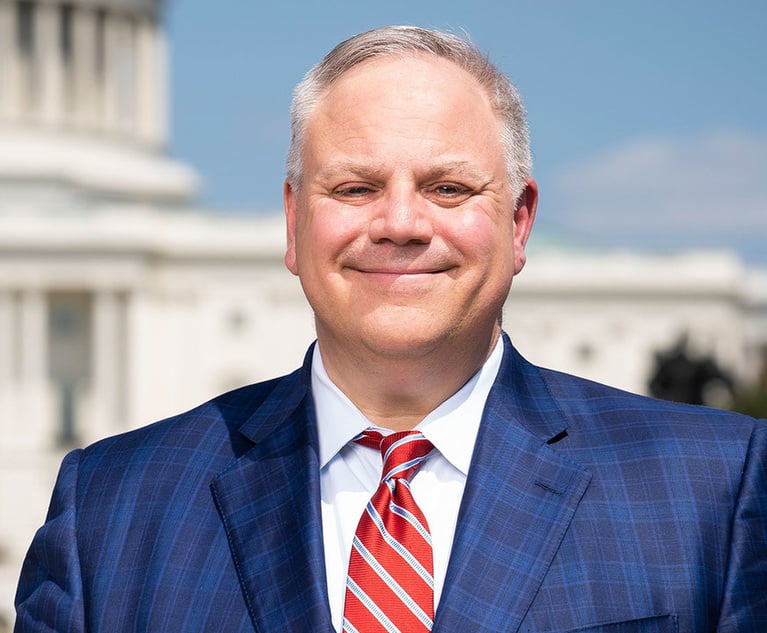How One Firm Used Marketing Intelligence to Inform a Combination
To get both sides to commit, Eversheds Sutherland realized it could no longer stick to traditional marketing and business development approaches.
September 03, 2018 at 08:48 PM
6 minute read

Not so long ago, legal marketing was nothing more than making things look pretty. As law schools flooded the United States with new grads in the 2000s and businesses demanded more from their counsel, we moved into an era in which law firms realized that marketing was no longer an afterthought.
The law never has been as competitive as it is today, and this trend shows no signs of abating. Marketing is increasingly vital to law firms, with its sophisticated emphasis on business development, technology, branding, innovation, strategy and creativity. I have had a front-row seat to this evolution of marketing at Eversheds Sutherland. Our recent combination and step up onto a global platform has demonstrated to us just how important marketing intelligence can be in making strategic decisions.
A New Approach
Eversheds and Sutherland Asbill & Brennan began combination discussions nearly a year before making a public announcement. While I was not part of the initial coffee talk, I was pulled in once the talks became serious because firm leaders recognized that marketing could help assess the needs of our clients and how a combination might support their business objectives. Having visited with many of our clients over the previous year, I was able to bring a well-rounded view of the impact a broader footprint would have on our U.S. clients.
As the talks progressed and the firms made a commitment to the proposed combination, we realized in order to truly align the business entities to a common strategy we needed to align our people to that strategy. It no longer made sense to abide by the traditional marketing and business development organizational chart that aligns people by discipline.
We developed an approach that aligned our business development team with the pillars of our strategic plan. For example, in addition to having our business managers aligned to traditional practice groups, we also aligned those managers to sectors and industries. We built teams around key account management, international regions, sectors and industries, training and development, and growth and innovation. By reorganizing our talent in teams that support firm strategy versus continuing to support silos of people based on disciplines, our people now are able to bring a more client-centric approach to the assistance they continue to provide for practice groups.
Focus on the Client
While our practice groups still exist, we are changing the way we think about clients. Our focus is on what our clients need, rather than on what a given practice group may offer within that silo. Most law firms tend to be built around practice groups, and we are certainly not the first to realize how such an orientation can limit the recognition of cross-practice opportunities. Our transition to a global footprint, however, was a trigger to take more formal steps to structure our firm in client- and industry-centric teams. We now make decisions by asking ourselves if the services that we sell are aligned to what our clients need and want to buy.
This shift is not something that is accomplished overnight. Much of what we do continues to center on practice groups, but over time we are integrating client-centric thinking by focusing our market strategy by sector and industry. Our conversations center on how to help our clients meet their business goals and objectives, not just on ratcheting up business for one practice.
As a result, we have become much more attuned to the expertise we have to offer from all over the world, and our lawyers are more likely to think about how we might provide additional services for clients beyond their practice area. We also have changed our incentives: We now have a system in place that provides financial reward for successful collaboration.
Innovative Solutions
A big part of this shift in thinking is to actively promote innovation in our processes. We took the lead on this by piloting a new app called Idea Drop that eventually will be rolled out to all our employees. The idea is to have a platform that allows everyone to easily drop an idea into the app, where people can comment and build on it. My favorite word in the English language is “and.” No matter what idea you come up with, it is great to hear someone add their own view by adding “and” to the original idea. It takes a village and the sum of the parts is always greater than the whole when you truly embrace collaboration.
We also are piloting a client conversation app that will allow our lawyers to become fully versed on various elements of our services, sectors and industries in order to have a comprehensive discussion around innovative solutions that have worked for clients across the globe. Client secrets won't be shared, of course, but we expect to learn from this opportunity to see how colleagues globally are finding solutions for clients.
Connect the Dots for Clients
This change in outlook builds on our long-held identity. Our lawyers have built a solid reputation on being client-centered, and we are a firm that takes pride in our responsiveness and in the relationships we have developed. Historically, we were niche-oriented, and for a long time that served us well. But even without the exponential expansion brought about by the combination, we knew that corporate consolidation and the demand for more efficient legal services was pushing us to re-evaluate our client service model.
Every law firm has to learn to connect the dots, finding ways to serve their clients from a broader perspective. Now, with a department aligned to strategy rather than discipline, we come to our marketing and business development discussions with a new sense of clarity.
While joining in a regional or global combination is not unique in today's rapid-paced professional services landscape, our reorientation on the marketing and business development side holds lessons for all law firms that want to thrive in an environment where clients focus on the holistic value of law firm relationships.
Erin Corbin Meszaros is the chief business development and client service officer at Eversheds Sutherland. Contact her at [email protected].
This content has been archived. It is available through our partners, LexisNexis® and Bloomberg Law.
To view this content, please continue to their sites.
Not a Lexis Subscriber?
Subscribe Now
Not a Bloomberg Law Subscriber?
Subscribe Now
NOT FOR REPRINT
© 2025 ALM Global, LLC, All Rights Reserved. Request academic re-use from www.copyright.com. All other uses, submit a request to [email protected]. For more information visit Asset & Logo Licensing.
You Might Like
View All

Three Akin Sports Lawyers Jump to Employment Firm Littler Mendelson

Brownstein Adds Former Interior Secretary, Offering 'Strategic Counsel' During New Trump Term
2 minute read
Trending Stories
Who Got The Work
J. Brugh Lower of Gibbons has entered an appearance for industrial equipment supplier Devco Corporation in a pending trademark infringement lawsuit. The suit, accusing the defendant of selling knock-off Graco products, was filed Dec. 18 in New Jersey District Court by Rivkin Radler on behalf of Graco Inc. and Graco Minnesota. The case, assigned to U.S. District Judge Zahid N. Quraishi, is 3:24-cv-11294, Graco Inc. et al v. Devco Corporation.
Who Got The Work
Rebecca Maller-Stein and Kent A. Yalowitz of Arnold & Porter Kaye Scholer have entered their appearances for Hanaco Venture Capital and its executives, Lior Prosor and David Frankel, in a pending securities lawsuit. The action, filed on Dec. 24 in New York Southern District Court by Zell, Aron & Co. on behalf of Goldeneye Advisors, accuses the defendants of negligently and fraudulently managing the plaintiff's $1 million investment. The case, assigned to U.S. District Judge Vernon S. Broderick, is 1:24-cv-09918, Goldeneye Advisors, LLC v. Hanaco Venture Capital, Ltd. et al.
Who Got The Work
Attorneys from A&O Shearman has stepped in as defense counsel for Toronto-Dominion Bank and other defendants in a pending securities class action. The suit, filed Dec. 11 in New York Southern District Court by Bleichmar Fonti & Auld, accuses the defendants of concealing the bank's 'pervasive' deficiencies in regards to its compliance with the Bank Secrecy Act and the quality of its anti-money laundering controls. The case, assigned to U.S. District Judge Arun Subramanian, is 1:24-cv-09445, Gonzalez v. The Toronto-Dominion Bank et al.
Who Got The Work
Crown Castle International, a Pennsylvania company providing shared communications infrastructure, has turned to Luke D. Wolf of Gordon Rees Scully Mansukhani to fend off a pending breach-of-contract lawsuit. The court action, filed Nov. 25 in Michigan Eastern District Court by Hooper Hathaway PC on behalf of The Town Residences LLC, accuses Crown Castle of failing to transfer approximately $30,000 in utility payments from T-Mobile in breach of a roof-top lease and assignment agreement. The case, assigned to U.S. District Judge Susan K. Declercq, is 2:24-cv-13131, The Town Residences LLC v. T-Mobile US, Inc. et al.
Who Got The Work
Wilfred P. Coronato and Daniel M. Schwartz of McCarter & English have stepped in as defense counsel to Electrolux Home Products Inc. in a pending product liability lawsuit. The court action, filed Nov. 26 in New York Eastern District Court by Poulos Lopiccolo PC and Nagel Rice LLP on behalf of David Stern, alleges that the defendant's refrigerators’ drawers and shelving repeatedly break and fall apart within months after purchase. The case, assigned to U.S. District Judge Joan M. Azrack, is 2:24-cv-08204, Stern v. Electrolux Home Products, Inc.
Featured Firms
Law Offices of Gary Martin Hays & Associates, P.C.
(470) 294-1674
Law Offices of Mark E. Salomone
(857) 444-6468
Smith & Hassler
(713) 739-1250









